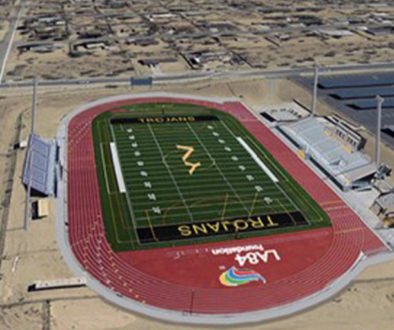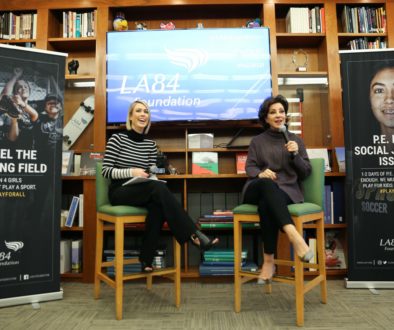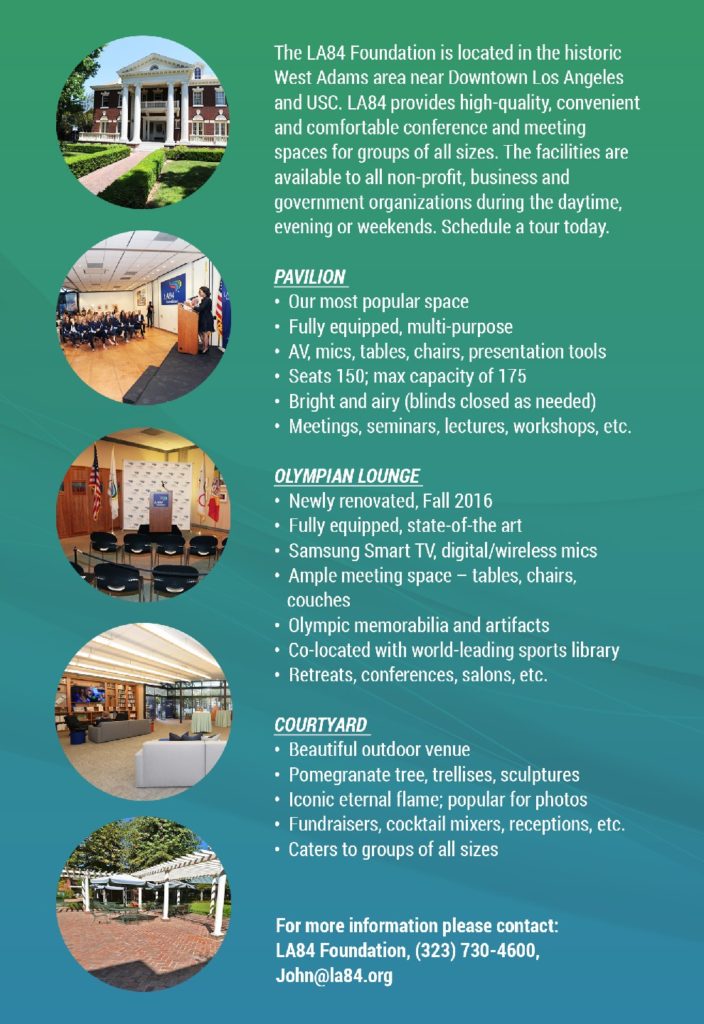SL Interview: Awista Ayub Brings Soccer and Strength to Afghan Girls
Born in Afghanistan, Awista Ayub fled to the United States with her family when she was two. The year was 1981 -– two years after the Soviet Union’s military invasion of Ayub’s homeland. Her family never returned.
Ayub was a college student at the time of the terrorist attacks of September 11, 2001, an event that caused her to reconsider her heritage as well as her connection to America. She was driven to act, she writes, because “like so many fellow citizens in the aftermath of 9/11, I felt the need to do something.”
In 2003, Ayub decided to establish the Afghan Youth Sports Exchange. The following year, she brought eight girls to the United States from Afghanistan for a soccer leadership camp. The eight had grown up as children of violence and turmoil: first, the civil war that engulfed Afghanistan after the Soviet Union’s withdrawal from Afghanistan in 1988-89; then, the oppressive reign of the Taliban following the civil war; most recently, the U.S.-backed military initiative that ousted the Taliban regime.
In the U.S., the eight girls trained for six weeks, competed in the Afghan-American Soccer Cup tournament and represented their country in the International Children’s Games. Later, Ayub returned to her homeland to visit the girls and lead soccer clinics at Ghazi Stadium, in Kabul, where the Taliban had carried out executions and torture.
In “However Tall the Mountain: A Dream, Eight Girls, and a Journey Home” (Hyperion; Amazon), Ayub chronicles the story of her efforts to bring soccer to Afghan youth and to empower girls through sport. At once poignant and instructive, the memoir is a tale of redemption and triumph that shines a unique light on Afghan culture.
In May, Ayub earned her masters in public administration from the University of Delaware, with a concentration in international sports development. On Sept. 11, 2009, SportsLetter spoke with Ayub on the phone from her home on the East Coast.
— David Davis
SportsLetter: You were born in Afghanistan but came to the United States when you were two. Why did your family decide to leave Afghanistan?
Awista Ayub: The Marxist-led coup in ’78 created an environment that my parents felt was not safe. My dad was working for the government as an engineer at the time, and he and my mother felt that it was important to get the family out. I was two at the time we left in ’81, but I have no memories of the country or of us fleeing.
It was supposed to be a temporary stay. I think for millions for Afghans who fled the country after 1978, there was initially a sense that, “Oh, we’ll return once there’s calm and order brought to the country.” That never happened. Ten years after we left, my parents were settled in the States, raising their three kids, and had accepted their life here.
SL: Growing up in Connecticut, what was your sports background?
AA: Being part of an immigrant family, sports was definitely not a priority. There were more immediate needs that my parents had to address for our family. So, I stumbled into sports at a much later age than most kids in America are introduced to sports. I was an avid “SportsCenter” watcher – I watched ESPN religiously every morning and drove my siblings crazy because they just weren’t into sports the way I was, but it wasn’t until high school, when I joined the tennis team, that I was really involved in organized athletics.
Sports has played a very strong and prominent role in my life from that point forward. Even in academia, pursuing my undergraduate degree [in chemistry at the University of Rochester], I wrote a paper about the impact of sports with women, and how women who play sports tend to do better in science and math.
SL: In the aftermath of the Sept. 11 terrorist attack, you write that you “felt the need to do something.” What made you decide to form the Afghan Youth Sports Exchange?
AA: That was a very personal decision, growing up here as an immigrant and looking at my own identity as an Afghan-American and a Muslim woman who played sports. Looking at what I embodied, it made sense for me, in giving back, to make a difference through sports because it’s played such a prominent role in my own upbringing in the States. I felt that, after years of war, sports would be one way to help youth re-integrate into society and help them find a voice and a passion within their own lives.
There was no one doing that sort of work or I would have coordinated with them. But, that’s how I ended up starting my own organization and embarking on this unique and audacious idea to bring a girls’ soccer team from Kabul to America. I was very young -– 23, 24 at the time -– so I probably didn’t understand the true impact of my work until much later.
SL: How would you describe the mission of the Afghan Youth Sports Exchange?
AA: The mission was to use sports as a tool to promote leadership within the youth ranks. When we recruited the girls in 2004, there were no girls’ soccer teams in Kabul to recruit from. We looked at their leadership potential and their maturity, in being able to handle a trip so far from home. The goal was that the girls would learn the sport here and when they went back to Afghanistan, they would help promote the sport in their own communities. And that’s what’s happened: several of the girls have become leaders in teaching the sport to other young girls.
SL: You chose soccer as the sport for the program, but you soon found out that few girls play the sport in Afghanistan. Why is that?
AA: Well, it’s important to realize that we’re an anomaly in the States. Here, soccer has become one of the most gender-neutral of sports. With the influence of Title IX and the success of the women’s national team, soccer is very popular for girls. But, as I learned, in reading books like “How Soccer Explains the World” [by Franklin Foer] and in traveling, that’s not the case outside of the U.S. Internationally, soccer is still very much a male-oriented sport.
In Afghanistan, soccer is the number-one sport among men. It has a very long history and plays a prominent role within society. What I didn’t realize was the reason we couldn’t find girl soccer players in Afghanistan was because this wasn’t a sport that girls played. I attributed it to the fact that, after 30 years of war, the general sports culture was re-establishing itself and so that’s why there were no girls playing soccer. I didn’t understand until much later that it was the cultural norm: basketball and volleyball are much more ingrained in the culture among girls and women in Afghanistan.
SL: Had the eight girls that your organization brought to the U.S. in 2004 ever played soccer before?
AA: No, they had no formal soccer training at all. They’d probably played some pickup soccer, and once they were selected to the program they got together to practice with the organization we were working with on the ground in Afghanistan. When they came here, they were really learning the basics of the sport: how to lace up your shoes, how to use your shin-guards, how to kick the ball with the front of your foot versus your toes. They picked it up quickly, over the course of six weeks, and came a long way in a short amount of time.
SL: Growing up in Afghanistan, what athletic opportunities did these eight girls have?
AA: Not much at all. They grew up in a very rough time. For those who were a little older and in school before 1996, when the Taliban came in, there really weren’t formal sports programs in the schools. They might have played some pickup volleyball or basketball games in their backyards.
When the Taliban was in charge [between 1996-2001], girls had no opportunity to play sports. Schools were closed for girls, except for secret schools that existed here and there, but sports wasn’t in the forefront of the culture at the time.
The sad reality is that, because the schools were closed for so long, girls who were ten were at the same reading level as girls who were five. There’s a huge discrepancy in terms of the literacy and education rate.
SL: The book chronicles their experiences in the U.S., as well as their lives back in Afghanistan. What most surprised you in getting to know these girls and in telling their stories?
AA: Their resiliency and their spirit. That’s why I chose the title of the book [which comes from an Afghan proverb] -– “however tall the mountain, there’s always a road” – because that’s how I’ve always viewed Afghan culture. My story is no different from that of many Afghan immigrants who’ve come to the States and other countries. We find a way to make our lives better and to make it work.
That’s also indicative in these girls’ lives. Despite the obstacles and the tragedies they’ve faced, they view their lives with such hope and optimism that they can overcome it. When they get opportunities, they seize them and they rise to the challenge and try to create a better life for themselves. They don’t view themselves as victims. And, that’s something that I found remarkable.
SL: How have their lives changed because of their involvement in the AYSE? Do they still play soccer? Are you still in touch with them?
AA: Yes, I’m still in touch with them. Some continue to play soccer, and some don’t. For those that continue to play, you see this bond as a team. That was most interesting to me, this notion of having this team come together. Early on, they were struggling on an individual level. They had never played organized sports before, so the idea of teamwork and trust and relying on others, in a culture where there has been violence and war every day of their lives, was something new to them.
They formed a strong-knit community with each other. They became sisters, on and off the field, and that for me was interesting -– to see how their lives have changed. I can’t say that it’s all because of the program, but I’ve seen in them a greater sense of confidence from when I first met them. Certainly, playing soccer and playing sports contributed to some degree.
SL: What was it like for you to return to Afghanistan in 2006 and 2007, to conduct clinics there, and to visit with the eight girls through the AYSE?
AA: My first trip, in 2006, was definitely a very overwhelming experience. I didn’t know what to expect and there were some fears. I had never been back to Afghanistan since I was two. I was traveling alone for the most part. My language skills weren’t up to par at times, and I struggled with communication.
I also made some mistakes along the way in getting re-integrated with the culture. One time, a male driver came with me into one of the houses where I was a guest. None of the women came to speak with me because a male stranger and not a member of their family had come into the house. The second time there was a lot easier for me. I knew people now and I was more comfortable with the language.
Overall, it was a positive experience. Growing up here in the States, and seeing what was happening in my homeland, I never thought I would ever be able to go back. Over time you just let go of that hope. So, when I had my plane ticket in my hand to go back, it was like a dream.
SL: Ghazi Stadium, built in 1923 in Kabul, was the national sports stadium. But it also served as the site of executions during the Taliban regime. What did it feel like to be in that stadium?
AA: It was overwhelming for me in the sense that I’d seen those images from the Taliban era as well. But when I was there, it was filled with athletes training and practicing, young girls running around the track and playing basketball. They were doing work on the field, so I was seeing new grass being put down, seeing a stadium full of life again. I choose to remember those images today. Hopefully, this new life can replace those unfortunate images from years ago.
SL: Do you consider the stadium a symbol of torture or a symbol of hope?
AA: I choose to consider it a symbol of hope. I think it’s overcome the time from the past and, hopefully, we’ll never return to that again.
SL: When we think of youth sports in the U.S., we think of Little League and AYSO. What are youth sports like today in Afghanistan?
AA: There’s a lot more opportunities for education again, so at the school level you see athletic teams and activities for girls. A lot of schools have gym teachers to organize recreational activities like we have here. At the federation and at the Olympic levels, the involvement of youth within the sports structure is very popular. This is all new since 2001, 2002.
SL: Has soccer caught on in Afghanistan among girls and women?
AA: The Afghan football federation started a women’s program in 2005, which these girls fed into very nicely. The federation has hundreds of girls registered with their leagues and their teams. Locally, the federation has done a great job with starting teams in Kabul and some of the surrounding towns outside of Kabul. It’s great to see that sports has helped to contribute to the nation-building of the country.
SL: Are there other sports options for girls and women in Afghanistan?
AA: Definitely, the options have expanded tremendously and girls have shown interest in this. Besides soccer, basketball and volleyball and table tennis are very popular among the girls. I’ve even heard of a boxing program in Kabul. So, you’re seeing girls participating and getting support from their families.
SL: Are female athletes in Afghanistan allowed to train in public? Do they have to cover their heads and their bodies when they play?
AA: Certainly, they’re dressed more conservatively than we see here. But that’s the culture. When you see girls playing sports there, they’re wearing pants and long-sleeved T-shirts. Some wear their headscarves, and others wear baseball caps to cover their hair. They make that decision with what they feel most comfortable wearing.
One of the things that the federations are strict about is making sure that the environment that the girls are playing in is respectful and comfortable. There are usually no men around when they’re practicing. If there are one or two men around, they might be the coach or the trainer. It’s very much a female-only environment that provides safety and security and a comfort level for the girls. That was one of the main concerns of the federations when girls started to play: to make sure that there weren’t men just hanging out in the field and watching them.
SL: How about the coaches?
AA: You’ll see a combination of men and women. For basketball and volleyball, you’ll see more women because there’s a history of the sport. You’ll see women who might have played when they were younger.
For soccer, it’s a little different. The women’s national team coach, who’s a former national team player, is male because there’s no woman as skilled as him. What’s interesting is you’re seeing girls who now have some experience playing the sport stepping up to be coaches locally.
SL: How do the sports programs for Afghan girls and women compare to programs in other Muslim countries?
AA: I think it’s much more at the grassroots level in Afghanistan. They’re still very much in the development stage and putting programs into place on the ground. But they have to start somewhere.
Of course, other countries have benefited from not having had 30 years of war ravage their country. So, when you look at Turkey and Jordan and even Egypt, their women’s programs are further along.
SL: For the past 30 years, Afghanistan has faced invasion, war, regime changes, and much violence. What do sports mean in the country today? Is it escape, entertainment or part of the culture?
AA: I think it’s a little bit of everything. It’s interesting that, right after the Taliban left Kabul, the first thing that people did was to play buzkashi [a sport played on horseback and banned by the Taliban] , which is a national sport. They congregated to play that. For me, that was so symbolic in how sports can play a role in re-invigorating a country and providing national unity and identity. Sports in Afghanistan, on the whole, has begun to provide that: it’s provided an outlet for expressing one’s individuality and for creating this new identity for the country with more hope and optimism.
Sports in Afghanistan also provides some level of entertainment, obviously not to the degree that we see here in the States. But you now see youth playing sports. Anytime you see an open area, it’s very common to see kids playing soccer or volleyball or doing something recreationally. It certainly provides an outlet for them.
SL: What is the next step for AYSE?
AA: I’ve shifted in my thinking. What I’ve learned is I can help more in terms of programmatic support to local officials and players — providing funding and grassroots support — versus leading the charge. I’ve done some work with a girls’ soccer program in Morocco that a colleague of mine, Nicole Matuska, started. She and I worked on bringing these girls to the States in 2008 to attend the Julie Foudy Sports Leadership Academy, through a fellowship grant I was awarded from the Dutch organization Women Win.
I’ve come to understand that I can play a positive role in helping to support Muslim women’s sports teams as a whole. I realize that, through my work and then visiting other Muslim women’s countries, some of the issues in Afghanistan regarding women’s sports programs and their need for more resources and support are synonymous with other countries. So, if I can do anything to make a difference on a larger, global scale, that’s where I hope I can make a difference.
SL: Have you returned to Afghanistan since 2007 or has the country become too dangerous?
AA: I haven’t returned, not necessarily because it’s dangerous. Since I came back in the fall of 2007, I’ve been busy with graduate school and working on the book. Those two projects have kept me busy. I hope to go back again soon.




